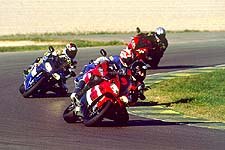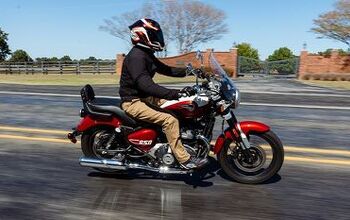First Ride: Y2K Yamaha YZF-R1 - Motorcycle.com
Valencia, Spain, December 20, 1999 -- We could write this review in one sentence: The Year 2000 Yamaha YZF-R1 is an awesome motorcycle.
Although that's about all most people need to hear, we feel we owe it to Yamaha and a few pesky readers to extrapolate a bit with more detail. Sure, we'd rather you take our word so we can turn off our computers and go riding, but in the interest of professional journalism we'll park our bikes, take off our helmets and fire off a few more words on what is basically a great motorcycle.
To understand the YZF-R1's place within the motorcycle universe, a short history lesson is in order. When Yamaha's YZF1000 debuted in 1996, the world's motorcycling press wondered, as spot-on as that bike was, how open-class motorcycles could become any better. The YZF1000 did everything right and nothing wrong. It had a brawny motor, a solid and well-balanced chassis, a dialed-in suspension and fantastic brakes. Even so, in 1998 Yamaha unveiled the R1 on an unsuspecting world and changed the perception of the limits of open-class supersport motorcycles.
The competition's open-class bikes available were geared, quite literally, more for top-speed honors and back-up sport-touring duties. But the Yamaha YZF-R1 changed the rules by successfully combining the awesome power available previously in open-class size with the lightweight and responsiveness that a 600-class chassis affords. Honda tried this with the CBR900RR and although they arguably created the modern liter-bike supersport class by pushing beyond the previous heights of the Suzuki GSX-R1100, it was, by no means mechanically nor stylistically, the quantum leap forward the R1 made.
Thus Yamaha permanently altered the sportbike landscape. Yet when we heard they would hold a world press introduction for the Year 2000 R1, we wondered why they would go to such lengths. Could Yamaha have altered an already revolutionary motorcycle so much and soon to justify an expensive undertaking such as a worldwide press intro? Perhaps Yamaha was concerned about the notoriously short-attention span of the industry press and, with the upcoming challenge from Honda's all-new CBR929RR, they wanted to maintain the R1's position as the top-of-mind cutting-edge sportbike among enthusiasts and the motorcycle press. Or perhaps Yamaha did indeed make one of the best sport motorcycles even better. Of course we weren't complaining, we simply wouldn't know until Spain. New Life Nothing of mechanical importance in this shot. Just a cool, post-industrial, minimalist kind-of-looking pic. When refurbishing the YZF-R1 for the Year 2000, Yamaha's main design goal was to sharpen the pre-existing bike and not redesign it. Even so they instituted over 150 changes in hopes of making an already light, sleek and mean motorcycle even lighter, sleeker and meaner. For example, even with the addition of the new Air Induction System, which weighs four pounds, the overall weight of the bike is down five pounds to a claimed 385 pounds dry. At a claimed 150 horsepower at the crank, top-end output remains the same but changes to the engine management system are supposed to result in a smoother, broader distribution of power.
We felt sorry for Minime so we agreed to run his picture a lot.
The bodywork is still unmistakably R1 although a few changes were made resulting in a 3% reduction in the drag coefficient. The headlight housing has a sharper profile, the side panels are more aerodynamic and slippery and the windscreen has been reshaped for better rider protection. In fact the bodywork changed so much that bodywork from previous R1s will not fit the Y2K edition.
Also updated is the seating area. The fuel tank is reshaped with a more relaxed rear angle and deeper leg recesses to provide for better rider feel. The seat extends further towards the front of the tank and the new, steeper seating position puts additional weight on the front end. All of this is aimed at improving weight bias and offering sharper cornering and more stability. Again, the resounding theme here is to sharpen what was already a very sharp package.
Yamaha improved chassis balance and cornering by adjusting the density of cast materials, improving the rigidity of the engine mount and reducing front-end dive with more progressive brakes.
Performance wise, Yamaha claims the year 2000 R1 provides improved aspiration, smoother shifting and better lubrication. The motor is equipped with Yamaha's new Air Induction System (AIS) that works off of crankcase pressure and a bladder-type device to pump air into the exhaust port after the mixture has been combusted. The Air Induction System will be found on all bikes worldwide and for track use it can be removed and the holes plugged. Reportedly this will not hinder performance.
The carburetors have been rejetted in an effort to improve throttle response -- especially in the low end -- all the way up to the bike's 11,750 rpm redline. The redesigned camshafts are lighter and use internal oilways to lubricate journals that, when combined with reduced tapped clearance, provide less friction and create less engine noise. Also changed within the crankcase is the gearbox featuring a taller first gear, a hollow chrome-moly shift-shaft with an additional bearing and a completely redesigned shift linkage and foot pedal. These changes are aimed at nixing last year's transmission complaints as well as helping to transfer as seamlessly as possible the R1's prodigious power to the pavement.
More by MO Staff





































Comments
Join the conversation